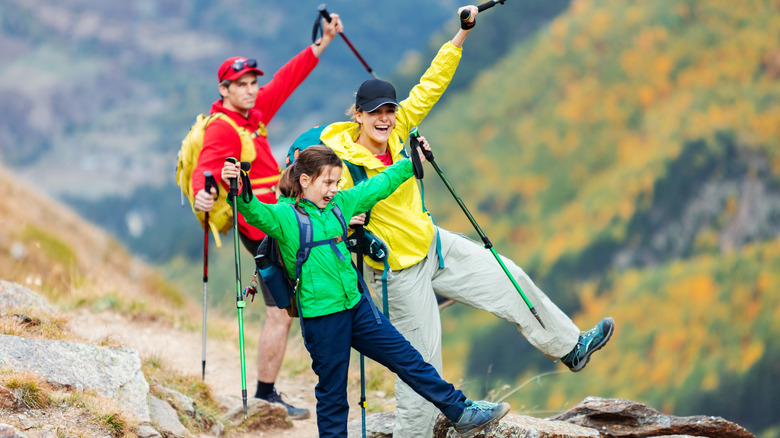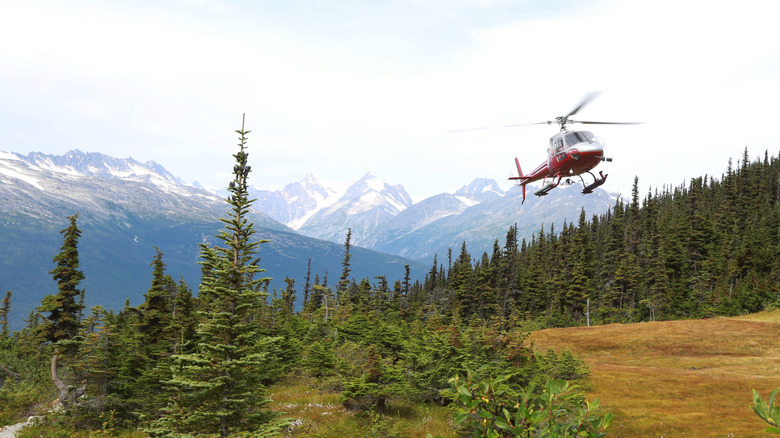The Clothing Colors National Park Services Recommends Wearing During Your Visit
In 2022, about 312 million people visited national parks in the U.S., per Reader's Digest. Out of that number, about 3,400 people were rescued using the National Park Service's (NPS) search and rescue (SAR) teams, according to Fox 13. To put the numbers further into perspective, 78,488 individuals were involved in 65,439 SAR incidents within national parks from 1992 – 2007 (per ResearchGate). The conclusion of the 15-year span showed 2,659 fatalities overall, 24,288 ill or injured people, and miraculously 13,212 saves. Furthermore, the national parks saw an average of 11.2 SAR incidents daily. Without the life-saving work that the NPS provides to those in distress, one out of five emergencies would end in death. Luckily, there are some easy ways to aid the SAR team if you are in need of rescue.
To start, it's extremely important to choose the right level of hike for your abilities. Avoid the trails that are only for experienced hikers unless you happen to be one. The NPS also asks that all visitors wear bright colors to any one of their 429 parks to aid them in case of an emergency. Many hikers prefer earth-colored clothing and items, and those colors are very common at most companies promoting hiking gear. Instead, choose the bright yellow tent (it'll be so much easier for you to find, too) and wear neon orange while cliff climbing — better safe than sorry. Most SAR operations cover miles of wilderness, and standing out from it is critical to your survival.
Save your life by wearing bright colors
Choosing to wear bright colors while hiking isn't just a fashion statement; it can be the difference between life or death for anyone who falls, becomes lost, or has any other emergency. It's also imperative to have the best gear when taking the hike. Otherwise, you might find yourself in avoidable trouble. The SAR helicopters have a tough job when a hiker is experiencing an emergency, but cannot pinpoint exactly where they are. In a 50,000-acre park, spotting someone in green or a dark color is nearly impossible, especially if it's early morning or early evening when the SAR is out.
Dress in bright-colored clothing according to the time of year. In the winter, everything is brown, so any bright colors work well. If it's snowing, the same applies. In the spring and summer, when everything is in full bloom and painted in shades of bright green, it can be very challenging to spot hikers in trouble. Opt for bright orange, pink, or yellow. Avoid wearing neon green during that time of year. In fall, it's a bit tricky since the falling leaves are yellow, orange, red, and brown. In this case, wear neon blue or pink. Don't be afraid to wear multiple bright colors, either. If your entire outfit is loud, it will only help you. Another important tip is to always carry a satellite phone. Many of the best hiking spots are far from civilization and cell towers.
A few more words about bright colors in parks
When setting off on an outdoor adventure, it's not just your clothing that needs to be brightly colored. When SAR helicopters are circling an area, they are looking for any signs of the injured hiker — this includes any of the hiker's supplies. As mentioned, a bright-colored tent is essential. Also, opt for a bright-colored water bottle, shoes, backpack, and anything else that might stand out against a green and brown background. The overgrowth is thick during the spring, summer, and most of the fall. If you are injured in a densely covered area, it's important to get whatever you have that's brightly colored out in the open, so the SAR helicopters will spot it. Tie-dye is another excellent option, since it will likely contain several bright colors and be impossible not to notice on a natural backdrop.
The National Park Service is not responsible for you when you embark on an adventure in a national park. It is up to you to be smart about your safety and the safety of those hiking with you. If you are planning to hike solo, be sure to always let someone know where you are going and when you will return so they can alert emergency services if you are not back by a certain time. Dress like you're going hiking in the 1980s, and don't forget the flares and first-aid kit. Trust us, you look great in neon pink.


